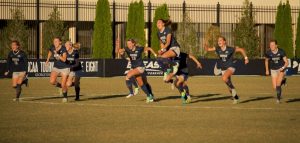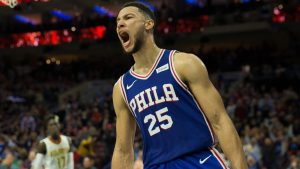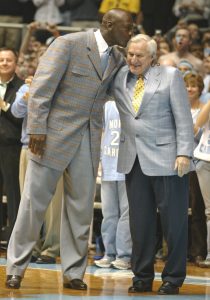Because sports fans are obsessed with categories, we tend to associate each basketball position with a specific set of skills and responsibilities. The center towers over the rest and sparks fastbreaks by grabbing rebounds, while the power forward provides the muscle of the team. The shooting guard hits jump-shots and plays great defense, while the point guard is the quarterback, controlling the well-oiled machine. The small forward, however, is another strand altogether. He’s the jack of all trades, with the size of a forward and the agility of a guard. He can be the offensive centerpiece or the defensive foundation depending on the needs of his team.
Each of these positions were defined by a legend, revolutionary at their time, who would set the expectations for those who followed. Cousy turned the role of the point guard into that of a showman whose stage is the hardwood. Russell and Chamberlain paved the way for centers for centuries to come with their dominance. But hardly anyone knows who preceded the great small forwards of history, setting the stage for legends like Larry Bird and Lebron. Unfortunately, we won’t be leaving Lakerland this week, because this man, the vintage small forward, is none other than Elgin Baylor.
If you’ve been following this column, you know that every big man I’ve talked about has been a household name. From Wilt Chamberlain to Bill Russell, the legends of the ‘60s and ‘70s are all stars who were underappreciated in their time, but treasured now as legends who bore the gauntlet of discrimination. If you haven’t heard of Elgin Baylor, however, you’re not alone. Elgin bore the same gauntlet as Wilt, Russell, and Robertson, but he never stood atop the basketball world as a black NBA champion. Elgin never found the appreciation and recognition that his counterparts found in retirement. His was a career of hardship just like Bill or Wilt, and just like the other legends of the ‘60s, he changed the game of basketball forever.
They say Bill Russell changed basketball from a horizontal game to a vertical game, but Elgin Baylor went further and changed what it meant for basketball to be a vertical game. At 6’5 and 225 pounds, Baylor could do it all. He would dazzle fans with passes that foreshadowed the creativity of the Steve Nashes and Chris Pauls to come, and he could put the ball to the ground and drive to the hoop like Lebron or Kobe. He was the first jack of all trades, the man who did everything for a team that went nowhere, and he paid the price as his legacy faded in retirement.
Like so many black athletes of his era, Elgin’s road to the NBA was anything but easy. He faced discrimination, ignorance, and second-class treatment at every step of his career. Racism placed obstacles in the way of his talent, and the same hardships of discrimination that marked the careers Oscar and Russell fell on Baylor. While it destroyed Oscar and emboldened Russell, it simply bounced off of Elgin most of his career. He was always the good-natured, talkative city boy from the District. While it didn’t hurt his personality, however, it certainly hurt his career, and there was a point when the high school dropout didn’t seem to be going anywhere. Thanks to a friend, however, Elgin finished school and found himself at Seattle University, where his domination on the court turned his life around. As scouts from across the country came far and wide to see the 6’5 small forward play, they were dazzled as he went up for rebound after rebound and then proceeded to whip the ball behind his back for full-court passes like he was a 6-foot guard. Soon enough, he found himself a hotly pursued prospect for the NBA, and he forwent his final year of college to begin his professional career playing for the Minnesota Lakers.
In just his rookie year, Elgin finished with averages of 25 points, 15 rebounds, and 4 assists a game, top ten in each category and deserving of rookie of the year honors. Pretty soon, he earned the reputation of the player who could do anything: he could rebound right up with the biggest giants in the game, score profusely, and pass the ball as creatively and as innovatively as Bob Cousy. But his real magic, his real legacy, was in his ability to take off and fly. It wasn’t that he could jump the highest, or even the farthest, it was his ability to take off, just like anyone else, and hang in the air long after everyone else came down. He would fake one way, then jet off in another direction, positioning himself and simply waiting for his defender to drop back down to the ground. Baylor could do anything he wanted because he only had to wait out his defender in the air. And thus Baylor played his own unique role in changing the sport of basketball to the game people love today. Cousy made basketball an art, Russell made it a vertical game, but Baylor redefined verticality in basketball. He taught the league that it didn’t always matter how high or far you could jump. In later decades, athletes like Michael Jordan and Dominique Wilkins would give new meaning to the idea of basketball players taking flight, but it was Elgin Baylor that opened the door to a new era of aerial basketball. It was Baylor that taught us how to fly.
Yet few remember the Father of Flight, because Elgin’s career never went where Russell’s or Wilt’s did. He was never able to harness the racism he faced as a tool to improve his play. While Russell became the greatest champion there ever was, Elgin never won a title, and soon after being called up to active military service in 1961, Baylor succumbed to knee injuries that ultimately ended his career. Remembered only as the talented forward hampered by bad knees and an even worse team, Elgin Baylor’s real legacy is too often forgotten. In a franchise that later saw the likes of Jerry West, Kobe Bryant, Shaquile O’Neal, and championships upon championships, fans forget the decades in which they struggled. As a result, they forget the finest small forward LA will ever see, and one of the finest the NBA has ever known. He finished with career averages of 27 points, 13 rebounds, and 4 assists: pretty astounding numbers in all three categories. Fans, however, don’t like to see dominance without rings. They forget the man who carried their franchise through the transition to Los Angeles, the man who did more for his position than almost any other player in the history of basketball, the man who invented flight.





